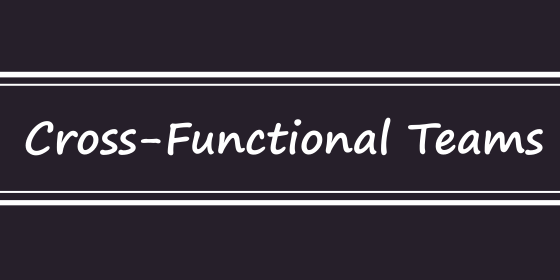Cross-Functional Teams

A Cross-Functional Team is a group of individuals with diverse skills, expertise, and backgrounds who work together to achieve a common goal or objective. In the context of Agile development methodologies, such as Scrum or Kanban, cross-functional teams play a crucial role in delivering valuable products and services efficiently. Below you will find a short description of Cross-Functional Teams and what benefits you can expect when having Impactful Cross-Functional Teams.
Key characteristics of a Cross-Functional Team
Here are some of the key characteristics of Cross-Functional Teams, and what they are expected to cover.
- Diverse Skills: Each member of the team possesses unique skills and knowledge, representing different areas of expertise relevant to the project or product. For example, a software development team might include roles like developers, testers, UX designers, and product specialists.
- Collaborative Culture: Cross-functional teams collaborate closely with one another, breaking down silos and encouraging open communication. Team members respect each other’s expertise and work together to address challenges and achieve objectives.
- Self-Organizing: Cross-functional teams are self-organizing, meaning they have the autonomy to manage their own work and make decisions collectively. The team collectively determines how to accomplish their goals and identifies the most effective approach.
- Shared Accountability: The team is collectively accountable for the success of the project or product. Success and challenges are shared, promoting a sense of ownership and responsibility among team members.
- Reduced Handoffs: Having all the necessary skills within the team reduces the need for extensive handoffs between different departments or individuals, leading to faster and more efficient delivery.
- Adaptability: Cross-functional teams are adaptable and can respond quickly to changing requirements or market conditions. They have the flexibility to adjust their approach and priorities based on feedback and new insights.
- Faster Delivery: By eliminating dependencies on external teams and decision-makers, cross-functional teams can deliver work more rapidly and with higher quality.
Benefits of Impactful Cross-Functional Teams
Establishing Cross-Functional Teams isn’t always easy, but once you have worked your way through the challenges, you will be able to start harvesting some of the benefits of having Impactful Cross-Functional Teams.
- Diverse Expertise: Cross-functional teams bring together people with different skill sets and perspectives. This diversity of knowledge and experience can lead to more innovative and creative solutions to problems.
- Holistic Approach: With members from various departments, cross-functional teams can consider multiple aspects of a project or problem, leading to well-rounded and comprehensive solutions. This can prevent tunnel vision and help in addressing potential issues from different angles.
- Faster Decision-Making: Cross-functional teams often have the authority to make decisions without the need for excessive hierarchical approvals. This can lead to quicker decision-making and faster project progress.
- Improved Communication: Collaboration between team members from different functional areas can enhance communication across the organization. Silos are reduced, leading to better information sharing and understanding between departments.
- Higher Accountability: Members of cross-functional teams are collectively responsible for the success of the project. This shared accountability can lead to a greater sense of ownership and commitment to achieving the team’s goals.
- Skill Development: Team members can learn from each other, gaining exposure to different areas of expertise and expanding their own skill sets. This can contribute to personal and professional growth.
- Adaptability: Cross-functional teams are often better equipped to adapt to changing circumstances, as they have a diverse skill pool that can quickly pivot and address new challenges.
- Innovation: Combining different perspectives and expertise can lead to innovative solutions that may not have been considered within traditional, siloed departments.
- Employee Engagement: Working in cross-functional teams can be more engaging and motivating for employees, as they have the opportunity to collaborate with colleagues from various parts of the organization.
- Customer-Centric Approach: Cross-functional teams can focus on delivering value to customers by considering all aspects of a product or service, from design and development to marketing and support.
Despite the numerous benefits, it’s important to note that managing cross-functional teams can also present challenges, such as potential conflicts between team members from different departments, communication barriers, and the need for effective leadership and coordination. However, when properly managed and supported, the advantages of cross-functional teams often outweigh the drawbacks.
If you are looking to learn more about Cross-Functional Teams and how to gain the benefits of having Impactful Cross-Functional Teams, then take a look at the Decision Distance Index or simply click “I want to learn more!”.